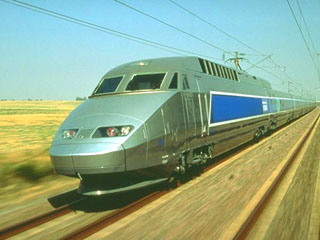
SNCF Photo.

SNCF Photo.
TGV is a system which comprises train, track, and signalling technologies to facilitate high speed rail travel. (typically 300 km/h, or 186 mph).
The idea was conceived in the 60's, but conventional thinking at the time was that technology for steel wheels on steel rails had progressed as far as it would, and so initially the project was refused any government funding.
"A completely new line was built beginning in the late seventies, running from Paris most of the way to Lyon. On 27 September 1981, the first section of the line was opened to revenue service by president François Mitterrand, and the streamlined, bright orange trains became instant celebrities." http://mercurio.iet.unipi.it/tgv/background.html
The TGV was an instant success, virtually grounding air traffic between Paris and Lyon, economists tantalised by the fact that the TGV actually turns a profit, paying for itself (including construction costs) in the first ten years.
There are a few fundamental differences between the TGV and conventional rail systems. The rails themselves are welded and supported on low maintenance concrete sleepers, just like many modern railroads; though ballast depth is greater, and track centers are further apart to reduce the blast of two high speed trains crossing.
A principle differences is in curvature, on a conventional railroad, 10 chains is considered a sharp curve radius - in high speed rail, a "tight" curve radius can be in the order of 3 miles! The outer rails are "super-elevated", or slightly raised which enables the train to negotiate curves at high speed.
The other striking difference is that there is no trackside signalling, as the indications are too difficult to read at high speed. Signalling information is transmitted digitally to the driver, who sees the indications on a display in the cab. Computers are responsible for the control of many important functions.
Another point worthy of consideration is that due to the proprtionately smaller loss of speed when ascending hills, tracks can be laid on much steeper grades than considered suitable for conventional rail. This makes location of routes much more flexible and therefore less expensive. The ruling grade on the original Paris to Lyon route was roughly 1 in 125. TGV technology permitted banks of up to 1 in 29 over the revised corridor.
Daily operation at speeds in excess of 300km has resulted in few incidents, and the TGV has an impeccable safety record, with 0 casualties reported in over 20 years of constant operation.
Resources
Gallery - TGV Web (European Railway Server)
Many thanks to Yannick Egermann - La Passion des Trains.
| Auran Website | Database | Locomotives | Trainz Website |